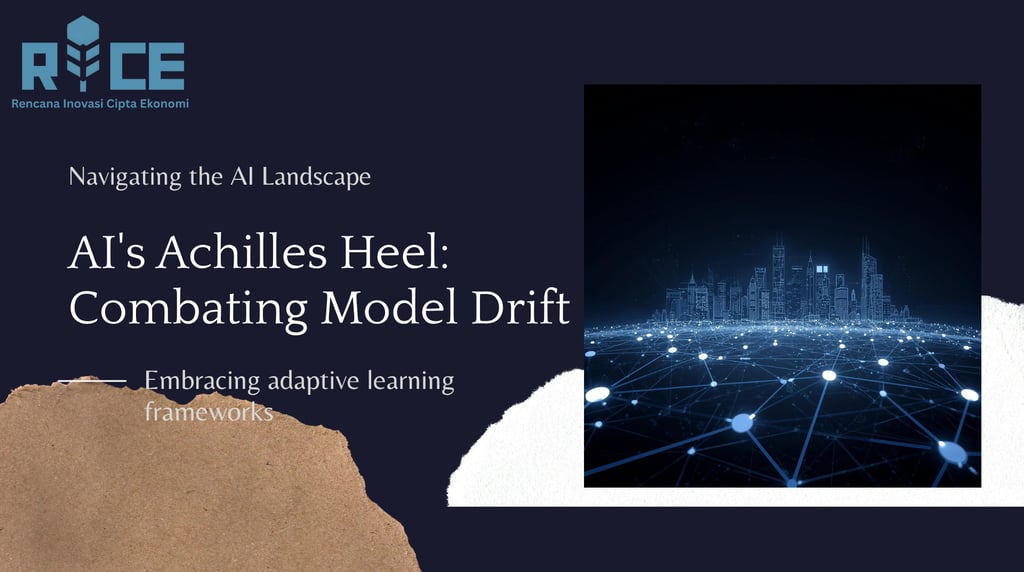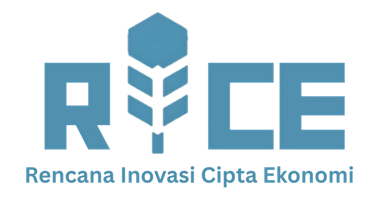AI's Achilles Heel: Combating Model Drift with Adaptive Learning & Continual AI Frameworks
Combat AI model drift with adaptive learning and continual AI frameworks. Understand drift, and discover strategies for building resilient, future-proof AI systems.
AI INSIGHT
Rice AI (Ratna)
10/10/20258 min read


In the rapidly evolving landscape of artificial intelligence, organizations invest heavily in building and deploying sophisticated machine learning models. These models, initially trained on vast datasets, promise unprecedented efficiency and insight. However, a silent, insidious threat often undermines their long-term efficacy: model drift. This phenomenon, where the performance of a deployed AI model degrades over time due to changes in the underlying data or relationships, represents a significant Achilles' heel for even the most advanced systems. Without proactive strategies, an AI system that once delivered cutting-edge results can quickly become obsolete, delivering inaccurate predictions and eroding operational trust.
The challenge of model drift isn't just a technical glitch; it's a strategic impediment to realizing the full potential of AI. It necessitates a paradigm shift from static model deployment to dynamic, evolving AI architectures. This article delves into the critical issue of model drift, exploring its manifestations and outlining the transformative power of adaptive learning and continual AI frameworks. For industry experts and professionals, understanding and implementing these advanced strategies is paramount to ensuring their AI investments remain robust, relevant, and continually deliver value in an ever-changing world. It's about empowering AI to learn, adapt, and thrive, rather than merely exist.
The Insidious Nature of Model Drift
The moment an AI model is deployed, it begins operating in a dynamic, real-world environment. This environment rarely remains static, meaning the conditions under which the model was trained will inevitably change. These changes directly lead to model drift, a fundamental challenge that affects virtually all production AI systems. Ignoring model drift is akin to launching a ship without a rudder, hoping it will continue on course indefinitely despite unpredictable currents.
Defining Concept Drift vs. Data Drift
Model drift manifests in primarily two forms: concept drift and data drift, both of which erode a model's predictive power. Understanding their distinctions is crucial for effective mitigation.
Concept drift occurs when the underlying relationship between the input variables and the target variable changes over time. The "concept" the model is trying to predict shifts. For instance, in a fraud detection system, what constituted fraudulent behavior yesterday might be different today due to new scamming techniques or evolving transaction patterns. The meaning of the labels changes, making the model's learned associations outdated.
Data drift, conversely, refers to changes in the distribution of the input data itself, independent of the target concept. The characteristics of the incoming data no longer match the characteristics of the data the model was originally trained on. Consider a recommendation engine; if user preferences or product availability significantly change, the input features fed into the model will look different, even if the core logic of "what makes a good recommendation" remains stable. Both types of drift lead to performance degradation, but they require different diagnostic and remedial approaches.
The Real-World Impact
The consequences of unaddressed model drift extend far beyond mere statistical inaccuracies. For businesses, decreased accuracy translates directly into tangible losses. A drift in a credit scoring model could lead to higher default rates, while drift in a predictive maintenance system might result in unexpected equipment failures and costly downtime. In customer-facing applications, degraded recommendation systems or chatbots can lead to poor user experience, customer dissatisfaction, and ultimately, a loss of trust in the AI system and the brand.
Furthermore, model drift can introduce or amplify biases if new data distributions inadvertently favor certain groups or lead to unfair outcomes. This ethical dimension is increasingly critical, making continuous monitoring and adaptation not just a performance necessity but also a governance imperative. The long-term erosion of trust, both internal and external, poses a significant threat to AI adoption and value realization, underscoring why combating drift is a top priority for responsible AI deployment.
Adaptive Learning: The First Line of Defense
As AI systems become more ubiquitous, the need for them to learn and adapt in real-time environments is paramount. Adaptive learning represents a critical first line of defense against model drift, allowing AI models to evolve gracefully as new data streams in. It's about shifting from a static mindset to one where AI systems are intrinsically designed to be responsive and self-optimizing.
Principles of Adaptive Learning
Adaptive learning embodies the principle that models should not be frozen in time after initial training. Instead, they should continuously learn from new, incoming data without the need for full, computationally intensive retraining from scratch. This approach is often characterized by incremental learning, where new data points are processed sequentially or in small batches, updating the model's parameters gradually. Online learning is a particular form of adaptive learning where the model is updated immediately upon receiving new data, making it highly responsive to real-time changes.
The core benefits of adaptive learning are multifold. Firstly, it offers significantly faster adaptation to environmental shifts, preventing prolonged periods of degraded performance. Secondly, it is remarkably resource-efficient compared to periodic full retraining, saving computational power and time. Lastly, it ensures that AI models remain highly relevant and accurate by continuously incorporating the latest information, maintaining their value proposition over extended periods.
Techniques and Algorithms
A variety of sophisticated techniques and algorithms underpin effective adaptive learning. Ensemble methods, for example, can be designed to dynamically weight or combine the predictions of multiple base models, with newer models or those performing better on recent data receiving more influence. Weighted windowing techniques assign higher importance to more recent data points during model updates, ensuring that the model prioritizes current trends over historical patterns that may no longer be relevant.
Specialized algorithms like ADWIN (Adaptive Windowing) or DDM (Drift Detection Method) are designed explicitly to detect concept drift and trigger model adjustments or retraining segments. These methods actively monitor the model's performance on new data and automatically identify when a significant change has occurred, prompting the system to adapt. Such intelligent monitoring and updating mechanisms are vital for maintaining the agility and accuracy of deployed AI solutions. (Link Suggestion: External link to a research paper on ADWIN or DDM algorithms).
Beyond Adaptation: Building Robust Continual AI Systems
While adaptive learning offers crucial real-time responsiveness, a more strategic and holistic approach is required for long-term AI resilience: continual AI frameworks. These frameworks move beyond simply reacting to drift, aiming to build AI systems that truly learn and evolve over their entire lifecycle, much like human intelligence.
What are Continual AI Frameworks?
Continual learning, often referred to as lifelong learning, is the ability of an AI model to continuously acquire, accumulate, and refine knowledge over extended periods without forgetting previously learned information. Unlike traditional AI, which typically undergoes discrete training phases and then deployment, continual AI models are designed to learn sequentially from a stream of data, retaining past knowledge while integrating new insights. This contrasts sharply with periodic retraining, where a model is often completely retrained from scratch or fine-tuned on a new, combined dataset, which can be inefficient and risks overwriting previously learned, valuable representations.
The fundamental goal of continual AI is to create intelligent systems that are truly adaptive and robust, capable of maintaining high performance even as their operating environment undergoes profound changes. It's about building "living" AI that grows with experience, making it a cornerstone for future-proof AI deployments.
Key Components and Strategies
The primary challenge in continual learning is "catastrophic forgetting," where a model, upon learning new tasks or concepts, inadvertently loses its ability to perform previously learned tasks. Addressing this requires innovative architectural and algorithmic strategies.
Replay-based methods store a small subset of past data (or synthetic data generated from past knowledge) and replay it alongside new data during training, effectively reminding the model of what it already knows. Regularization-based methods add penalties to the loss function during training to prevent critical weights associated with old knowledge from changing too much (e.g., Elastic Weight Consolidation (EWC) or Learning without Forgetting (LwF)). Architectural methods involve dynamically expanding the model's capacity or using modular networks, allowing new knowledge to be acquired in new parts of the network while preserving existing knowledge.
At Rice AI, we specialize in developing sophisticated continual AI frameworks designed to help enterprises overcome catastrophic forgetting and ensure their AI models remain performant and relevant over extended periods. Our approach integrates state-of-the-art techniques to facilitate seamless knowledge transfer and robust model evolution. These multifaceted strategies are essential for building AI systems that are not just reactive but truly intelligent and capable of sustained learning.
Practical Steps for Mitigating Model Drift
Implementing adaptive and continual AI is not just about choosing the right algorithms; it requires a systematic approach encompassing robust monitoring, strategic retraining, and a solid MLOps infrastructure. Proactive management of model drift is critical for sustaining the value of AI investments.
Data Monitoring and Anomaly Detection
The first and most crucial step in combating model drift is continuous and comprehensive data monitoring. This involves closely tracking both the characteristics of the incoming input data and the behavior of the model's predictions. Tools and techniques for drift detection should be integrated directly into the production pipeline. This can include statistical methods to compare current data distributions with baseline training distributions (e.g., Kolmogorov-Smirnov test, Population Stability Index), or analyzing changes in feature importance.
Furthermore, monitoring model output metrics such as accuracy, precision, recall, or F1-score on a validation set (if ground truth becomes available) is essential. Establishing clear, actionable thresholds for drift detection is vital. When these thresholds are crossed, it should trigger automated alerts to human operators or initiate predefined adaptive responses within the system. Early detection minimizes the period of degraded performance and prevents minor drifts from escalating into major failures.
Strategic Retraining and Model Updating
Once drift is detected, a strategic approach to retraining and model updating becomes necessary. Retraining doesn't always mean a full rebuild from scratch. It can involve fine-tuning the existing model on new data, retraining only specific layers in a deep learning model, or updating an adaptive learning component. Triggers for retraining can be scheduled (e.g., monthly updates), performance-based (e.g., accuracy drops below a threshold), or data-driven (e.g., significant data drift detected).
The balance between the cost of retraining (computational resources, human oversight) and the benefit of improved performance is a key consideration. Often, a human-in-the-loop validation process is invaluable, allowing experts to review detected drift, assess its severity, and approve or guide retraining efforts. This hybrid approach combines the efficiency of automation with critical human intuition and domain knowledge, ensuring responsible and effective model evolution.
Infrastructure and MLOps Considerations
Robust MLOps (Machine Learning Operations) pipelines are the backbone of any successful strategy to combat model drift. MLOps provides the framework for continuous integration, continuous delivery, and continuous training (CI/CD/CT) specifically tailored for machine learning models. This includes automated processes for data versioning, model versioning, testing, deployment, and monitoring.
Tools for automated deployment ensure that updated or retrained models can be seamlessly integrated into production with minimal downtime. Monitoring tools not only track drift but also observe the overall health and resource consumption of the AI system. Establishing clear rollback strategies is also critical; if a newly deployed model exhibits unforeseen issues, the ability to quickly revert to a previous, stable version is paramount. A well-engineered MLOps infrastructure makes it possible to manage the complexity of evolving AI systems, turning the theoretical solutions of adaptive and continual learning into practical, operational realities.
The Future-Proofing Imperative for AI
The pervasive challenge of model drift underscores a fundamental truth about AI in the real world: static models are destined for obsolescence. As environments, data, and user behaviors continuously shift, AI systems must be empowered to evolve. Adaptive learning provides the immediate responsiveness needed to address transient changes, while comprehensive continual AI frameworks offer the strategic long-term solution for building truly robust and resilient intelligent systems. This proactive, dynamic approach is not merely a technical refinement; it is a strategic imperative for any organization seeking to extract sustained value from its AI investments.
Embracing these advanced paradigms means moving beyond the traditional "train once, deploy forever" mentality. It involves designing AI with intrinsic mechanisms for self-correction, knowledge retention, and continuous improvement. This ensures that AI doesn't just perform tasks but truly learns and grows alongside the business, adapting to new challenges and seizing emerging opportunities. The future of AI is not in fixed algorithms, but in flexible, intelligent systems capable of perpetual evolution.
Understanding and actively combating model drift is not merely a technical exercise; it is a strategic imperative for any organization leveraging AI. By embracing adaptive learning and continual AI frameworks, businesses can unlock the full, enduring potential of their intelligent systems. Don't let your AI become obsolete—empower it to learn, adapt, and grow.
For expert guidance in implementing robust adaptive learning and continual AI solutions, partnering with specialists like Rice AI can provide the clarity and technological advantage needed. Our team helps organizations build resilient AI architectures that thrive in dynamic environments, transforming challenges into opportunities for sustained innovation. Contact Rice AI today to discuss how we can future-proof your AI investments and ensure your intelligent systems remain at the forefront of performance and innovation. The journey towards truly intelligent, self-evolving AI begins now.
#AIDrift #ModelDrift #AdaptiveLearning #ContinualAI #MachineLearning #AIOps #MLOps #AIStrategy #FutureOfAI #ArtificialIntelligence #TechTrends #DataScience #AIEvolution #IntelligentSystems #RiceAI #DailyAIInsight
RICE AI Consultant
To be the most trusted partner in digital transformation and AI innovation, helping organizations grow sustainably and create a better future.
Connect with us
Email: consultant@riceai.net
+62 822-2154-2090 (Marketing)
© 2025. All rights reserved.


+62 851-1748-1134 (Office)
IG: @riceai.consultant
